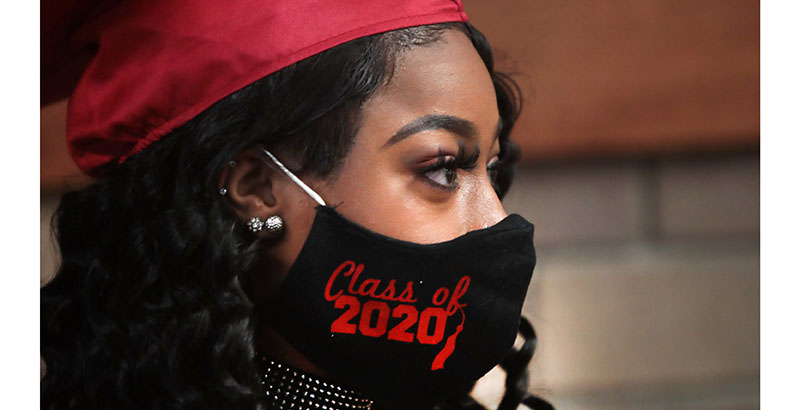Coronavirus Must-Reads for Schools: Polls Show Parents Are Skittish About Trump’s Push to Reopen Campuses, Judging Claims of Ed Tech Companies, Graduating Into a Pandemic & More

This is a special edition of EduClips, our recurring roundup of top education headlines from America’s 15 largest school districts, where more than 4 million students across 10 states typically attend class every day. See our full EduClips archive right here.
When should schools open? Even at the highest levels of government, opinion is divided. Last week, Dr. Anthony Fauci, the nation’s leading epidemiologist, warned of “little spikes” of climbing disease rates that “might turn into outbreaks” if states fail to meet federal guidelines before opening schools. President Trump called Fauci’s reply to lawmakers “not an acceptable answer” and reiterated that “we have to get the schools open, we have to get our country open.”
A new poll released Wednesday by Politico/Morning Consult suggests that more voters are on Team Fauci than Team Trump. Predictably, however, the results skew along political lines. In an online survey of roughly 2,000 registered voters, 41 percent called reopening K-12 schools in the fall a bad idea, but among those with a favorable view of Trump, 54 percent favored reopening elementary and high schools this fall.
Politics, perhaps as much as science, will play a huge role in determining when and where schools reopen. If the target is indeed the fall, district and state leaders have roughly three months to weave the many variables facing them into coherent plans. They have gotten a leg up from think tanks, national teachers unions and the federal Centers for Disease Control, all of which have released blueprints to guide reopening.
But as Education Dive noted in an analysis of those blueprints, many are more easily written than accomplished. For example, a Maryland plan calls for temperature screening checkpoints before students enter school, which Dan Domenech, executive director of the AASA, The School Superintendents Association, called an “an immense logistical issue” at a time when many schools have cut back on nurses. The biggest X factor may be academic: how to address the epic amount of lost learning due to students being at home for months. A survey by Education Week suggests that schools have been “all over the map” in terms of the rigor of their online instruction. As school winds to a close for the academic year, at least one state is trying to measure the depth of the trough. Texas is offering an end-of-year assessment to gauge the size of what has become known as the “COVID slide.” However, the test is optional and may therefore be of limited value.
Top Stories
Ed tech — Ed Tech Companies Promise Results, but Their Claims Are Often Based on Shoddy Research (Read at The Hechinger Report)
Stimulus — Why did The CARES Act Give More Money to Hair Schools Than to a Community College? (Read at NBC News)
Reading — Teaching Reading Was Hard Before a Pandemic. Now Chicago Teachers Walk a Tightrope of Technology and Attention (Read at Chalkbeat)
Pandemic lessons — An American Principal in Africa Is Using Lessons From the Ebola Epidemic to Confront COVID-19. U.S. Educators Can Learn From Him (Read at The74Million.org)
Class pets — Who’ll Take the Tortoise? What Happens to Classroom Pets During the Lockdown (Read at NPR)
Parents and Families
The Class of 2020: Graduating Into a Pandemic (Read at The Washington Post)
Youngest Learners Prepare to Start School — Without the School: Summer Transition Activities Help Acclimate 5-Year-Olds to the Classroom. Can a Remote Version Even Come Close? (Read at Education Dive)
Still Trying to Get a Handle on Schooling From Home? Home-Schoolers Know a Thing or Two (Read at the Los Angeles Times)
‘It’s Working Fantastically’: Two Parents on Adjusting to Their Lockdown Role of Proxy Teacher (Read at The Guardian)
With School Buildings Closed, Children’s Mental Health Is Suffering (Read at NPR)
Educators
Helping Students Grieve From a Distance (Read at Education Week)
From NYC Parents to Principals, Mayor De Blasio’s Decision During COVID-19 to Fill Teacher Openings From Troubled Absent Teacher Reserve Sparks Worries (Read at The74Million.org)
39,000 NYC Students With Disabilities Attend School Year-Round. Their Parents Are Bracing for the Summer (Read at Chalkbeat)
Oral History — 5 School Leaders, 4 Weeks & the Biggest Education Crisis of Their Careers: How San Antonio Marshalled Its Early Forces to Face the Coronavirus Shutdown (Read at The74Million.org)
Equity and Activism
Low Attendance and COVID-19 Have Ravaged D.C.’s Poorest Schools. Fall Will Be About Reconnecting (Read at The Washington Post)
Closing the Digital Divide: Inside Cleveland’s Plan to Treat Broadband Like a Public Utility Service — and to Pay for Every Student to Get Online (Read at The74Million.org)
For Some LGBTQ Youth, School Buildings Were Safer Spaces Than Their Homes. Now, They Have Nowhere to Go. (Read at Chalkbeat)
In Montgomery County, Schools and Parents Clash Over How Much Teachers and Students Are Connecting (Read at The Washington Post)
Essays and Reflections
During Lockdown, Google Maps Gives My Son a Way Out From Our Kitchen in Queens: He Had Created a Paracosm — a Fantasyland. And His Journey Has Led Him Not to Mordor but to Minor-League Baseball Stadiums. (Read at Wired)
Where’s the Rallying Cry? America’s Children Are Unequally Prepared to Absorb The Impacts of COVID-19 (Read at Brookings)
Rotherham: From Homeschooling to the Digital Divide to Philanthropy, 10 Questions About COVID-19 and the Future of Education (Read at The74Million.org)
The Coronavirus Is Rewriting Our Imaginations (Read at The New Yorker)
Worst. Summer Break. Ever. How One D.C. Third-Grader Is Bracing for the Pain of Quarantine Without the Pleasure of School (Read at The74Million.org)
QuotED
“When I am missing two thirds of my kids each day, there is a ceiling to how well it can go. But I am proud of what we have done and how the school is responding. We’re making the most of a bad situation.” —Jonathan Faber, who teaches English and social studies to recent immigrants at Coolidge High in Washington, D.C. (Read at The Washington Post)
“My initial reaction was concern. In this moment, we are seeing that issues of equity become more entrenched. What we know about the ATR is that placement has disproportionately been in educational settings that are already disadvantaged. [These educators have been] going disproportionately into schools that have high needs and a high percentage of black and brown children.” —Paula White, the executive director of Educators for Excellence’s New York office, on plans to dip into the city’s infamous Absent Teacher Reserve to make up for teacher staffing shortfalls. (Read at The74Million.org)
“I understand there are equity issues. But I think there’s a way to have things fair and still provide more of a learning experience than kids are getting now.” —Brian Krantz, parent of a 12-year-old daughter in Montgomery County, Maryland. (Read at The Washington Post)
“We’d still have to have a robust online presence, because if there were to be a second wave or another outbreak, or if it were to become seasonal, the virtual has to be embedded in the school psyche.” —Jeff Trudeau, director of the American International School of Monrovia in Liberia, which was shuttered during the Ebola epidemic, on preparing for the fall. (Read at The74Million.org)
“I worry about the two frogs the most. They have the most care involved.” —Mary Pfeifer, New York City teacher, in an email to parents, asking who would be willing to invite classroom pets into their homes during the pandemic. (Read at NPR)
Get stories like these delivered straight to your inbox. Sign up for The 74 Newsletter

;)
